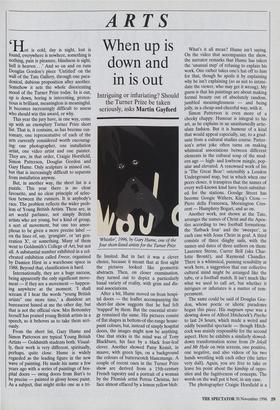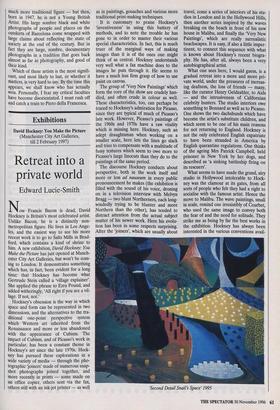ARTS
When up is down and in is out
Intriguing or infuriating? Should the Turner Prize be taken seriously, asks Martin Gayford Hot is cold, day is night, lost is found, everywhere is nowhere, something is nothing, pain is pleasure, blindness is sight, hell is heaven ...' And so on and on runs Douglas Gordon's piece `Untitled' on the wall of the Tate Gallery, through one para- doxical, dubious proposition after another. Somehow it sets the whole disorienting mood of the Turner Prize today. In is out, up is down, boring is interesting, preten- tious is brilliant, meaningless is meaningful. It becomes increasingly difficult to assess who should win this award, or why.
This year the jury have, in one way, come up with an exemplary Turner Prize short list. That is, it contains, as has become cus- tomary, one representative of each of the arts currently considered worth encourag- ing: one photographer, one installation artist, one video artist and one painter. They are, in that order, Craigie Horsfield, Simon Patterson, Douglas Gordon and Gary Hume. Only sculpture is missed out, but that is increasingly difficult to separate from installation anyway.
But, in another way, the short list is a puzzle. This year there is no clear favourite, and no clear principle of selec- tion between the runners. It is anybody's race. The problem reflects the wider prob- lem of Young British Artists. These are, in art world parlance, not simply British artists who are young, but a kind of group, a sort of movement, but one too amor- phous to be given a more precise label — on the lines of, say, ‘grungists', or 'art gen- eration X', or something. Many of them went to Goldsmith's College of Art, but not all. A substantial number exhibited in a cel- ebrated exhibition called Freeze, organised by Damien Hirst in a warehouse space in 1988. Beyond that, classification is hard.
Internationally, they are a huge success, being apparently the only significant move- ment — if they are a movement — happen- ing anywhere at the moment. `I shall scream if I hear the words "young British artists" one more time,' a dissident art bureaucrat hissed at me the other day, but that is not the official view. Mrs Bottornley herself has praised young British artists in a speech, so it behoves us to take them seri- ously.
From the short list, Gary Hume and Simon Patterson are typical Young British Artists — Goldsmith students both. Visual- ly, their work is very different, spiritually, perhaps, quite close. Hume is widely regarded as the leading figure in the new wave of painting. He made his name a few years ago with a series of paintings of hos- pital doors — swing doors from Bart's to be precise — painted in glossy house paint. As a subject, that might strike one as a tri- 'Whistler', 1996, by Gary Hume, one of the four short-listed artists for the Turner Prize fle limited. But in fact it was a clever choice, because it meant that at first sight the pictures looked like geometric abstracts. Then, on closer examination, they turned out to depict a particularly banal variety of reality, with grim and dis- mal associations.
After a bit, Hume moved on from hospi- tal doors — the leaflet accompanying the short-list show suggests that he had felt 'trapped' by them. But the essential strate- gy remained the same. His pictures consist of flat shapes in bottom-of-the-range house- paint colours, but, instead of simply hospital doors, the images might now be anything. One that sticks in the mind was of Tony Blackburn, his face by a black four-leaf clover. Another showed Patsy Kensit, in mauve, with green lips, on a background the colours of butterscotch blancmange. A couple of recent ones in the Turner Prize show are derived from a 15th-century French tapestry and a portrait of a woman by the Flemish artist Petrus Christus, her face almost effaced by a lemon yellow blob. What's it all mean? Hume isn't saying. On the video that accompanies the show, the narrator remarks that Hume has taken the `unusual step' of refusing to explain his work. One rather takes one's hat off to him for that, though he spoils it by explaining why he isn't explaining (so as not to intimi- date the viewer, who may get it wrong). My guess is that his paintings are about making formal beauty out of absolutely random, jumbled meaninglessness — and being jolly, in a cheap-and-cheerful way, with it.
Simon Patterson is even more of a cheeky chappy. Humour is integral to his art, as he explains in an unashamedly artic- ulate fashion. But it is humour of a kind that would appeal especially, say, to a grad- uate from a cultural studies course. Patter- son's artist joke often turns on making whimsical associations between different elements in the cultural soup of the mod- ern age — high- and lowbrow mingle, pop- ular and elevated. A renowned work of his is `The Great Bear': ostensibly a London Underground map, but in which when one peers closer, it transpires that the names of every well-known kind have been substitut- ed for the stations. Goodge Street has become Googie Withers, King's Cross — Piero della Francesca, Momington Cres- cent — Humphrey Bogart, and so on.
Another work, not shown at the Tate, arranges the names of Christ and the Apos- tles according to two football formations: the 'flatback four' and the 'sweeper', in each case with Jesus Christ in goal. A third consists of three dinghy sails, with the names and dates of three authors on them: Laurence Sterne, Currer Bell (aka Char- lotte Brontë), and Raymond Chandler, There is a whimsical, punning sensibility at work here, a suggestion that our collective cultural mind might be arranged like the tube, or a football match. It isn't much like what we used to call art, but whether it intrigues or infuriates is a matter of tem- perament.
The same could be said of Douglas Gor- don, whose poetic or idiotic paradoxes began this piece. His magnum opus was a slowing down of Alfred Hitchcock's Psycho to last 24 hours, which made a weird and oddly beautiful spectacle — though Hitch- cock was mainly responsible for the second aspect. Here he exhibits a similarly slowed- down transformation scene from Dr Jekyll and Mr Hyde on twin screens, one positive, one negative, and also videos of his two hands wrestling with each other (the latter very dull). Again, you are free to take or leave his point about the kinship of oppo- sites and the fugitiveness of concepts. The words on the wall put it best, in any case.
The photographer Craigie Horsfield is a much more traditional figure — but then, born in 1947, he is not a Young British Artist. His large sombre black and white photographs of people and places on the outskirts of Barcelona come wrapped with large claims about reflecting the state of society at the end of the century. But in fact they are large, sombre, documentary photographs in a tradition that goes back almost as far as photography, and good of their kind.
Which of these artists is the most signifi- cant, and most likely to last, or whether it matters, is very hard to say. By the time this appears, we shall know who has actually won. Personally, I fear my critical faculties have become disorientated. I must rush off and catch a train to Piero della Francesca.



















































































 Previous page
Previous page